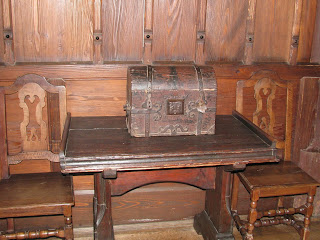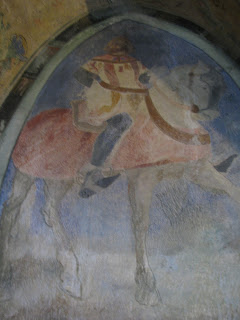Because castle water was impure, wine — less
alcoholic than today's beer — was the way knights got their fluids. The
pitchers on the wall were their daily allotment. The bellows were part of the
barrel's filtering system.
Stairs lead to the... Gothic Great Hall (1435).
This hall is set up as a kitchen, with an oven designed to roast an ox whole. The arms holding the pots have notches to control the heat. To this day, when Germans want someone to hurry up, they say, "give it one tooth more."
This hall is set up as a kitchen, with an oven designed to roast an ox whole. The arms holding the pots have notches to control the heat. To this day, when Germans want someone to hurry up, they say, "give it one tooth more."
A nearby wall is peeled away to show the wattle-and-daub construction (sticks, straw, clay, mud, then plaster) of a castle's inner walls.
Next comes the bedroom (Kremenate) of the owners. This was the only heated room in
the castle: the more recent stove for heat is behind the door, covered in iron plates.
The canopy kept in heat and kept out critters. In medieval times,
it was impolite for a lady to argue with her lord in public. She would wait for
him in bed to give him what Germans still call "a curtain lecture."
The deep window seat caught maximum light for handwork and reading. Women would sit here and chat (or "spin a yarn") while working the spinning wheel.
The deep window seat caught maximum light for handwork and reading. Women would sit here and chat (or "spin a yarn") while working the spinning wheel.
A noble bedchamber. The castle even has a great legend.
According to the story, the castle was originally known as Brauburg, and only
got its current name later. The daughter of one of the Eppstein owners,
Elizabeth, loved a handsome knight named Siegbert von Lahnstein, and the
families approved the match. But as the wedding preparations were underway,
Siegbert was summoned away to a war against Bohemia, and he was killed. Among
those who came to comfort the young lady was a monk named Mark.
The following year, a man appeared, a knight named Rochus
von Andechs who always wore black. He claimed to be Siegbert's cousin, and with
Siegbert's inheritance he tried to claim his bride, too. The Lord Eppstein was
in favor -- why let all those negotiations with the Lahnstein family go to
waste? But Elizabeth could not warm to him. She felt there was something very
wrong with Rochus that no one else in her family could see. So she turned to
Brother Mark for advice. The young monk also thought there was something odd
about Rochus and he prayed to Saint Mark for help. On the night before the
wedding Saint Mark appeared to the monk and told him that Rochus belonged to
the Prince of Darkness.
Brother Mark rushed to the wedding and burst in at the
crucial moment. Ignoring the shouts of the assembled families, he ran forward
and pressed his cross against the chest of the black knight. At this Rochus
silently stamped his foot on the ground, which swallowed him. Brother Mark then
told his story, and the castle was renamed in honor of the saint who had saved
the Eppsteins from an alliance with the devil.
The low and narrow door leads to the Hall of the Knights (Rittersaal). I think this was my favorite room in the burg.
This was the dining
hall. The long table is an unattached plank.
After each course, servants could replace it with another pre-set plank. Even today, when a meal is over and Germans are ready for the action to begin, they say, "Let's lift up the table."
The "action" back then was traveling minstrels who sang and told of news gleaned from their travels.
Again, the deep windows with seats, here around a table set with a chess game.
The outhouse – which jutted out of the wall over the outer bailey - locked from the outside (from the dining room side) because any invader knew that the toilet — which simply hung over thin air — was a weak point in the castle's defenses.
Then again through a tiny door into the private Chapel (Kapellenturm, 1372).
The fine niched statue is a Rhenish virgin mother from the 15th C.
This chapel is still painted in Gothic style with the castle's namesake, St. Mark, and his lion.
Even the chapel was designed with defense in mind. The small doorway out kept out heavily armed attackers. The staircase spirals clockwise, favoring the sword-wielding defender (assuming he was right-handed).
After each course, servants could replace it with another pre-set plank. Even today, when a meal is over and Germans are ready for the action to begin, they say, "Let's lift up the table."
The "action" back then was traveling minstrels who sang and told of news gleaned from their travels.
The outhouse – which jutted out of the wall over the outer bailey - locked from the outside (from the dining room side) because any invader knew that the toilet — which simply hung over thin air — was a weak point in the castle's defenses.
Then again through a tiny door into the private Chapel (Kapellenturm, 1372).
The fine niched statue is a Rhenish virgin mother from the 15th C.
This chapel is still painted in Gothic style with the castle's namesake, St. Mark, and his lion.
Even the chapel was designed with defense in mind. The small doorway out kept out heavily armed attackers. The staircase spirals clockwise, favoring the sword-wielding defender (assuming he was right-handed).
Passing by the
castle chaplain’s room, we pass a sand molded metal plate - like those used on the bedroom heating stove - showing the Wedding
at Cana.
Here we enter the Reinbau
(Rhine wing) erected in 1706. Across
the hall is the Linen Room with a loom, spinning wheel and tools for working
flax.
Around 1800, the castle — with
diminished military value — housed disabled soldiers. They'd earn a little
extra money working raw flax into linen.
Next you see 2000 years of armor in the Rustkammer, showing the evolution of armor since Celtic times.
This Carolinian knight was my favorite (and Aidan - other than the helmet and shoes - I think you and I could make it!)
Since helmets covered the entire head, soldiers identified themselves as friendly by tipping their visor up with their right hand. This evolved into the military salute that is still used around the world today. Armor and the close-range weapons along the back were made obsolete by the invention of the rifle. Armor was replaced with breastplates — pointed (like the castle itself) to deflect enemy fire. This design was used as late as the start of World War I.
A medieval lady's armor hangs over the door. While popular fiction has men locking their women up before heading off to battle, chastity belts were actually used by women as protection against rape when traveling or during wars. Some things never change.
This Carolinian knight was my favorite (and Aidan - other than the helmet and shoes - I think you and I could make it!)
Since helmets covered the entire head, soldiers identified themselves as friendly by tipping their visor up with their right hand. This evolved into the military salute that is still used around the world today. Armor and the close-range weapons along the back were made obsolete by the invention of the rifle. Armor was replaced with breastplates — pointed (like the castle itself) to deflect enemy fire. This design was used as late as the start of World War I.
A medieval lady's armor hangs over the door. While popular fiction has men locking their women up before heading off to battle, chastity belts were actually used by women as protection against rape when traveling or during wars. Some things never change.
Finally, in the very center, the Keep (Bergfried) : situated in one of the smallest
courtyards in Germany, this served as an observation tower, a dungeon (with a
22-square-foot cell in the bottom), and a place of last refuge. The lowest part
was built in 1239, the upper in 168. It
towers 40 m over the base. The only
entrance was 10 m above the ground, accessible only by a specially built ladder
or bridge from one of the walls. When
all was nearly lost, the defenders would bundle into the keep and burn the
wooden bridge and ladder, hoping to outwait their enemies.
Horse Stable: The stable currently shows off bits of medieval crime and punishment. The ceiling dates to 1239.
Horse Stable: The stable currently shows off bits of medieval crime and punishment. The ceiling dates to 1239.
As you leave the
inner castle thru the Eisern Pforte (Iron Gate), you walk – very carefully –
back down the Rider’s Stairway, passing the castle forge and blacksmith’s shop on your left.
Once out, we all took photos of each other and the castle and headed for the souvenir shop. Lots of cool swords and other weapons for children of all ages.
We then topped the midday off with one of our favorite new fast food meals: CURRY BRATS and pommes frites. I like EVERYTHING about this meal: the skin of the brats is crackly, the inside is juicy and bursting with flavor; the rolls are crusty yet moist and chewy inside; the french fries have great flavor and the curry sauce - slightly curried sweetened warm ketsup - is so good you want to sop it all up with the roll.























































Thanks for posting about Marksburg. We certainly didn't get as much out of it with Miss A screaming. :)
ReplyDeleteWONDERFUL post. thanks. so they could not lock the outhouse from the inside? Only the out? or both, Fascinating. Again thanx.
ReplyDeleteOnly the outside, which was inside the castle dining room. I imagine 'friends' played tricks on each other all the time.
Delete